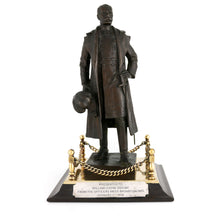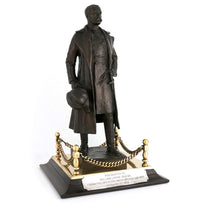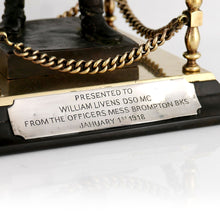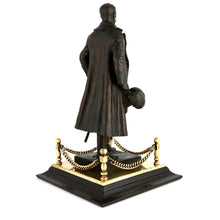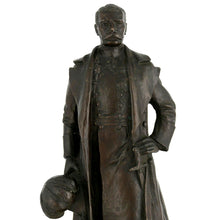Livens Projector - Royal Engineers Presentation Figure, 1918
- Regular price
- £3,600
- Sale price
- £3,600
- Regular price
-
- Unit price
- /per
Adding product to your cart
Overall height: 25.4cm (10in)
Provenance: Col William Livens, DSO, MC, RE (1889-1964)
Patinated bronze. Standing figure of Field Marshal Earl Kitchener of Khartoum modelled in greatcoat and undress frock coat with plumed hat in hand, and set on an integral base, with brass and Bakelite plinth appiled with plaque inscribed ‘Presented to / William Livens DSO MC / From the Officers Mess Brompton Bks / January 1st 1918’. Signed and dated. Height of bronze figure: 22.8cm (9in)
The present figure of Royal Engineer Lord Kitchener (1850-1916) was presented to wartime RE Colonel William Howard Livens DSO, MC (1889-1964), the inventor of the Livens Projector and a multitude of other schemes for delivering death to the enemy.
Read more
Educated at Oundle School, Christ's College, Cambridge, Livens was a civil engineer who volunteered on the outbreak of the First World War in August 1914. In August 1915 he was posted to one of the newly formed RE Special Gas Companies and was able to make immediate improvements in the way poison gas was released in the direction of enemy trenches. Livens was soon put in charge of Z Company, a special unit responsible for developing a British version of the Flammenwerfer that had recently been deployed on the Western Front. Livens responded with a massive fixed flame projector that was deployed in underground chambers on the Somme in 1916 with mixed results. During an attack in the prolonged Somme battle soon after, Z Company were called in to deal with a party of well entrenched Germans. Livens managed to hurl two five gallon oil drums into the German position with devastating effect, giving rise to the idea of developing a simple mortar buried into the ground at a 45 degrees that was capable of throwing canisters of toxic chemicals, poison gas and burning liquid into the enemy’s lines. In the conditions of close quarter, static trench warfare the weapon proved so simple to use and inexpensive that hundreds – and on occasions thousands – of projectors could be fired simultaneously.

Moreover Livens reported to the Ministry of Munitions ‘...if the projectors were used on a large scale the cost of killing Germans could be reduced to sixteen shillings each.’ The Livens Projector duly became the preferred means for delivering a chemical attack for years to come. Livens, ‘who was always full of ideas’, was ordered home to become a liaison officer between RE Special Brigade and the Ministry, in which role he remained for the last two years of the war. In 1924, Livens invented a dishwasher with all the features of a modern machine. Interestingly for an apparent materialist, Livens was an honorary vice-president of the Spiritualist Association of Great Britain and a great friend of Lord Dowding of Battle of Britain fame who had similar interests. In 1940, as a German invasion of Britain threatened, Livens joined the newly formed Petroleum Warfare Department under the directorship of Sir Donald Banks, who said of him - "Colonel Livens was the typical inventor. His equipment as one remembers it was an old club blazer with numerous pockets out of which explosives of all kinds, fuses, wire and gadgets would emerge and hey presto! the most surprising detonation would occur in disconcerting places.”









